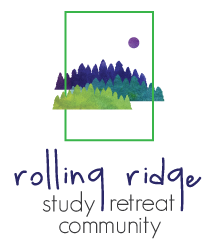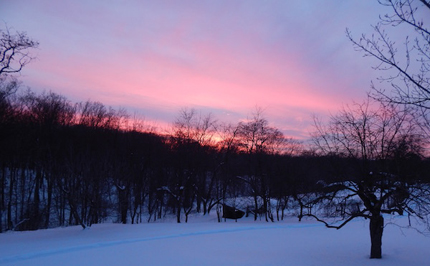Snow began falling Friday afternoon, lazily, drifting effortlessly from a soft gray sky. Within hours the mood had changed; it became swift and determined, tiny particles careening downward, as Mary Oliver says, “…irrepressibly” into a world “which is falling apart now, which is white and wild…” (“Walking Home from Oak-Head” in Thirst). After nightfall, outside, sweeping snow from the porch, steps, and path in a futile attempt to keep ahead of the storm, the flakes were shimmering, iridescent grains of light dancing in the beam of my headlamp.
It snowed all day and into the next night, and all that time, and for days afterward, wonder and beauty piled up around us: a full moon round and pale behind streaks of deep blue clouds; gold light touching the tops of snow-laden trees as the sun rose over the ridge; scarlet cardinals dancing on hillocks pristine and white; a sunset of delicate rose and coral splendor.
Beautiful too has been the bright warp and woof of communal caretaking and joy in the midst of this wonderland: all night Friday, through the wee hours and into the morning, Scot and Billy took turns driving the truck round and round in a noble (but doomed) try at keeping our lanes passable; every day has seen shared soup, chili, brownies, popcorn, and laughter. We’ve dug out an intricate warren of paths threading back and forth between our homes, held sledding parties, built snow sculptures, done puzzles, watched “Goofy Goes Skiing”. Yesterday morning Scot put on snowshoes and went the mile down Mission Road carrying another pair of snowshoes to meet Keith, who had managed to get home from New York as far as the road had been plowed. Together they snowshoed back up the long hill so Keith could be re-united with Katie and the rest of his loving community.
So is the shining picture of our nights and days in and after the storm, and I have been thinking about perception. It is one thing to observe and appreciate the natural and human world in the cradle of a snowstorm. It is something else to perceive it, to absorb it in heart and soul, to feel it in body, to let it peel back layers in mind. Then, as Annie Dillard writes in what may be my favorite passage of all time, “the mountains slam”:
When her doctor took her bandages off and led her into the garden, the girl who was no longer blind saw “the tree with the lights in it.” It was for this tree I searched through the peach orchards of summer, in the forests of fall and down winter and spring for years. Then one day I was walking along Tinker Creek thinking of nothing at all and I saw the tree with the lights in it. It was the backyard cedar where the mourning doves roost charged and transfigured, each cell buzzing with flame…The flood of fire abated, but I’m still spending the power…I have since only very rarely seen the tree with the lights in it. The vision comes and goes, mostly goes, but I live for it, for the moment when the mountains open and a new light roars in spate through the crack, and the mountains slam. — “Seeing”, Pilgrim at Tinker Creek
There is so much more than meets the eye.
It’s been sunny and well above freezing yesterday and today. The snow is melting, sliding avalanche-like off Woodhaven’s steep roof, soaking inch by inch into the earth, the whole snow pack lowering, like a deflating air mattress. The branches of the trees throw sharp tangled shadows across the radiant plane. It makes me think of surfaces and layers, the striations of being.
In The Wisdom Way of Knowing, Cynthia Bourgeault notes that sacred traditions recognize humans as a mix of matter and energy, body and soul. We and our perceptions exist between two realms. This is not only our given place in things: it is also our calling. Our task is to practice a sacred alchemy. She writes, “The secret of our identity does not lie in the outer form or in how successfully we manipulate the outer forms of the sensible world. Rather, it lies in how we are able to set them (and ourselves) aflame to reveal the inner quality of their aliveness. The names of God lie coiled within the physical forms of things; our particular and uniquely human task is to spring the trap and set them free.”
The snow will continue to melt, and the plow will reach us, perhaps this afternoon. Our snowbound idyll will end. We will go back to jobs and school, to chores and routines. Still the red-bellied woodpecker flashes red between the trees, Luke walks patiently back and forth many times with a wheelbarrow to the woodshed harvesting warmth for his family and for us, the azure sky glows, and the many layered universe flames and slams.

